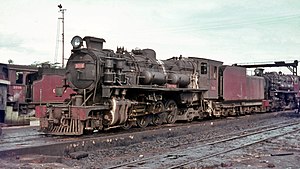From Wikipedia, the free encyclopedia
East African Railways 30 class
Specifications Configuration: •
Whyte
2-8-4 •
UIC 1′D2' h2
Gauge
1,000 mm 3 ft 3+ 3 ⁄8 in )
Driver dia. 48 in (1,219 mm)
Adhesive weight 51.2 long tons (52.0 t) Loco weight 77.7 long tons (78.9 t) Fuel type Oil Fuel capacity 1,950 imp gal (8,900 L; 2,340 US gal) Water cap. 7,000 imp gal (32,000 L; 8,400 US gal) Firebox: • Grate area 38 sq ft (3.53 m2 ) Boiler pressure 200 psi (1.38 MPa) Heating surface: • Firebox 146 sq ft (13.6 m2 ) • Tubes 1,680 sq ft (156 m2 ) • Total surface 2,272 sq ft (211.1 m2 ) Superheater: • Type Inside • Heating area 446 sq ft (41.4 m2 )
Cylinders 2
Cylinder size 18 in × 26 in (457 mm × 660 mm)
Valve gear
Walschaerts
The EAR 30 class was a class of oil-burning
1,000 mm 3 ft 3+ 3 ⁄8 in ) gauge
2-8-4
steam locomotives . The class was built in 1955 by
North British Locomotive Company in
Glasgow , Scotland, for the
East African Railways (EAR). Its design was derived from the
2-8-2
EAR 29 class , which, in turn, was based upon the
Nigerian Railways River class .
The 26 members of the class served their entire careers in
Tanganyika /
Tanzania , one of the three territories/countries served by the EAR.
Class list The numbers and names of each member of the class were as follows:
No. 3015 operating a freight train near
Morogoro , Tanzania, in 1967
See also References Notes Bibliography
Durrant, A E; Lewis, C P; Jorgensen, A A (1981). Steam in Africa . London:
Hamlyn .
ISBN
978-0-600-34946-4 OCLC
9014344 .
OL
15088099M .
Wikidata
Q111363476 . Patience, Kevin (1976), Steam in East Africa: a pictorial history of the railways in East Africa, 1893-1976 , Nairobi: Heinemann Educational Books (E.A.) Ltd,
OCLC
3781370 ,
Wikidata
Q111363477 Ramaer, Roel (1974). Steam Locomotives of the East African Railways . David & Charles Locomotive Studies. Newton Abbot, North Pomfret:
David & Charles .
ISBN
978-0-7153-6437-6 OCLC
832692810 .
OL
5110018M .
Wikidata
Q111363478 . Ramaer, Roel (2009). Gari la Moshi: Steam Locomotives of the East African Railways . Malmö: Stenvalls.
ISBN
978-91-7266-172-1 OCLC
502034710 .
Wikidata
Q111363479 . Staff writer (February 1956).
"The "30" Class Locomotive" . East African Railways and Harbours Magazine . 2 (7).
East African Railways and Harbours : 236. Retrieved 8 December 2014 .
External links
Media related to
EAR 30 class at Wikimedia Commons


![]() Media related to
EAR 30 class at Wikimedia Commons
Media related to
EAR 30 class at Wikimedia Commons


![]() Media related to
EAR 30 class at Wikimedia Commons
Media related to
EAR 30 class at Wikimedia Commons